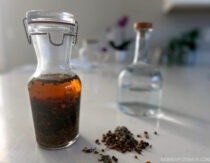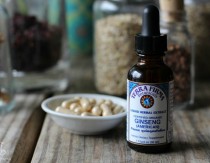
Have you heard about the good kind of brainwashing? It’s not a form of hypnotherapy and no weird soundtracks are involved, but it is a process that is absolutely vital for brain and neurological health.
Scientists have puzzled for years over how our brains detoxify, but thanks to a Danish neuroscientist named Maiken Nedergaard we now know.
Turns out, your brain has a rinse cycle, and how efficiently it works can impact your cognitive and neurological health.
So how does it work? Just like the rest of our body, our central nervous system (aka the brain and spinal cord) generates metabolic waste, and excess buildup can impair normal function. High levels of a metabolic byproduct called β-amyloid protein, for example, are thought to play a role in Alzheimer’s. (1)
Generally speaking, our body uses our lymphatic system to collect cellular sewage and empty it into the bloodstream, where it is then processed and eliminated by our liver, kidneys and other detox organs. But our brain doesn’t have any lymphatic vessels, so for a long time it was thought that it didn’t detoxify the same way.
Nedergaard changed all that when she discovered that the brain has its own unique lymphatic system enabled by glial cells. Originally called the “glial-lymphatic system,” it was eventually shortened to glymphatic system.
So how does it work, what impairs it, and how can we support healthy glymphatic function?
We’ll cover all that below, but first I want to mention that none of these statements have been evaluated by the FDA, this article is not medical advice, and it is not meant to diagnose or treat any condition. Now that we’ve got that out of the way, let’s dive in.
- What is the glymphatic system?
- So, how does it work?
- 7 Tips for Optimizing Glymphatic System Function
- 1. Prioritize Deep Sleep
- 2. Sleep On Your Side
- 3. Move Your Body
- 4. Make Sure Your Airway Is Functioning Optimally
- 5. Get Your Omega 3’s
- 6. Moderate Alcohol Consumption
- 7. Counteract Chronic Stress
- Want to dive deeper?
What is the glymphatic system? ^
You know how at the end of some days your brain just feels wiped – like you have done ALL you can do for the day and maybe a little more? All that activity – plus all the automatic things your central nervous system (CNS) handles like, um, breathing – generates cellular trash that can build up if not handled properly.
That’s where the glymphatic system comes in. It’s a unique system of water channels, pores and other pathways that acts as a waste clearance system, rinsing away lactate, urea, used protein and other cellular debris.
So, how does it work? ^
The glymphatic system is mostly inactive when we’re awake, but during sleep it fills channels in our brain (known as interstitial space) with cerebrospinal fluid (CSF). It doesn’t have a pump like our circulatory system does (the heart), but it does run parallel to our arteries and researchers think that it harnesses the pulsing of our blood to move the fluid.
Deep breathing and certain postures – particularly side sleeping at night – also support the flow of CSF. (2)
As it fills the channels, the fluid exchanges beneficial compounds for cellular garbage. It delivers nourishment including glucose, lipids, amino acids, growth factors, and neuromodulators while gathering cellular garbage.
The interstitial fluid is then flushed out, taking the cellular garbage with it. From there the fluid empties into the primary lymph system, where it is then processed via our main detox pathways.

7 Tips for Optimizing Glymphatic System Function ^
There are still some things we don’t know about the glymphatic system, like how it interacts with the blood-brain barrier and the specifics of how it empties into the meningeal lymph vessels. We know that it does, but the mechanisms are still unclear.
However, we have learned a few ways to support its function. Here’s an overview:
1. Prioritize Deep Sleep ^
Using EEG machines, researchers have found that surges of CSF fluid flow every 20 seconds or so when our brains are making delta brainwaves. (3) In plain English, that means the strongest surges of glymphatic flow happen during deep sleep.
Glymphatic system function tends to decline as we get older, probably due to a decrease overall sleep quality. Fortunately, there are a lot of things we can do to get deeper, more restful sleep – here are my top tips.
2. Sleep On Your Side ^
It’s no surprise that sleep quality influences how well a sleep-driven process works, but you might be surprised to hear that sleep position matters, too.
Researchers have found that side sleeping – especially sleeping on our right side – increases glymphatic waste clearance when compared to back or stomach sleeping. (4)
Here’s why: Gravity and intracranial pressure both influence how cerebrospinal fluid and blood move through the brain, and “Both intracranial pressure and cerebral hemodynamics are influenced by body posture.” (4)
Though some of the exact mechanisms are still being sorted out, it seems that how nerves and veins stretch in each position impacts venous drainage of the carotid veins. As mentioned above, our glymphatic system piggybacks off our circulatory system, so optimizing the flow of one may improve the other. (5)
As for why sleeping on our right side seems to produce the best results, gravity likely plays a role in this instance, too. When we lie on our right side, the pressure gravity exerts pushes toward our chest cavity instead of into our rib cage, which reduces pressure on the heart and optimizes output.
That said, everyone moves during sleep, and I don’t think anyone is suggesting that we all sleep on our right side all night. However, it may be something worth paying attention to – and maybe even trying to facilitate with body pillows and/or different setups – if supporting glymphatic flow is a top priority.
There is one exception, though. During pregnancy, women are advised to sleep on their left side after the 30th week of gestation. (6) This is because “the increasing weight of the uterus during pregnancy could compress the aorta (the central artery conveying blood to the upper and lower abdomen) and the inferior vena cava (the central vein returning blood from the lower abdomen to the heart).”

3. Move Your Body ^
Exercise can support immune function, mood and so much more . . . and part of that “more” includes glymphatic function.
Researchers have found over and over again that regular exercise benefits glymphatic flow. (7) (8) (9) (10)
As I mentioned above, our glymphatic system doesn’t have it’s own pump – it moves fluid by piggybacking off pulsations created by the circulatory system. Exercise is thought to help with this process by optimizing the quality of our arterial pulsations. (11) (12)
4. Make Sure Your Airway Is Functioning Optimally ^
Deep breathing during sleep increases the flow of CSF to the brain by creating negative pressure in the thoracic area. (13) On the flipside, sleep related breathing disorders like sleep apnea can impair glymphatic system waste clearance, and they’re more common than you might think. (14) (15)
Many people don’t realize that symptoms like waking up exhausted after a full night’s sleep may be an indicator of an issue, so they don’t pursue doing an at-home sleep study to find out for sure.
Though more research is needed to confirm the effect, this case report found that improving airway function via a CPAP machine improved biomarkers associated with cerebrospinal fluid waste clearance.
Though I’m not aware of any research on how it related to glymphatic function specifically, I’m also a huge fan of the Vivos mmRNA device for improving nighttime breathing. It’s approved to correct mild to moderate obstructive sleep apnea without the use of a CPAP.
My kids have been wearing their pediatric devices during sleep for years to help optimize their orofacial and airway development, and it has made a huge difference for them. I’ll write more about our experience soon, with details on sleep studies and photos. It’s been such a great experience that I’m not just a happy client, I’m a company advisor and investor, too. (And just in case you’re wondering, I did pay full price for my kids services.)
For some people, raising the head of the bed may also optimize airway flow. (16) Researchers usually call this approach HOBE, or Head-of-Bed-Elevation, while practitioners often call it Inclined Bed Therapy. Keep an eye out for a new article on the potential benefits soon.

5. Get Your Omega 3’s ^
In case you didn’t already have enough reasons to love salmon patties, smoked salmon dip and supplements like cod liver oil, researchers have found that fish rich in omega-3 polyunsaturated fatty acids have a positive impact on glymphatic function. Specifically, they:
- Support amyloid-beta clearance (17)
- Help a water-channel protein called aquaporin-4 (AQP4) maintain polarization at the astrocytic endfeet, which increases the swiftness of glymphatic clearance. (5) (17)

6. Moderate Alcohol Consumption ^
Research suggests that small amounts of alcohol may have a beneficial effect on glymphatic flow, while intermediate to high amounts impair it. In one study, mice “that were exposed to low levels of alcohol consumption, analogous to approximately 2 ½ drinks per day, actually showed less inflammation in the brain and their glymphatic system was more efficient in moving CSF through the brain and removing waste, compared to control mice who were not exposed to alcohol.” (18)
Larger amounts, however, had a detrimental effect.
With that said, as I discuss in this article, additional research suggests the optimal “low dose” range varies for men and women, with women being closer to one drink per day and men being between one and two. Just for reference, in the U.S. a standard drink is defined as:
- 12 ounces of regular beer, which is usually about 5% alcohol
- 5 ounces of wine, which is typically about 12% alcohol
- 1.5 ounces of distilled spirits, which is about 40% alcohol
7. Counteract Chronic Stress ^
Animal studies have shown that chronic stress impairs brain health in at least a couple of few ways, including:
- Decreasing glymphatic influx and efflux (the transport of cerebrospinal fluid into and out of the brain)
- Causing an increase of corticotrophin-releasing factor, which increases the release of amyloid-beta proteins (the ones we don’t want to accumulate) (19)
Modern life is constantly exposing us to stressors, but there are ways we can counteract it. Here are some of my favorites.
Want to dive deeper? ^
Here are some articles on whole body detoxification that you may find helpful:
Do you have a question about the glymphatic system? Please let me know in the comments below!
Want more research-backed natural remedies?
No problem, I’ve created a free ebook for you – Kitchen Apothecary: 25+ Natural Remedies Using Ingredients From Your Pantry – as a gift for signing up for my newsletter. You’ll also get updates when I post about safe essential oils for pregnant/breastfeeding mamas, exclusive gifts and coupons (I was able to give away a jar of free coconut oil to anyone who wanted it recently!), plus other goodies.
Sign up using the form below.
Sources
- M. Paul Murphy and Harry LeVine III (2010) Alzheimer’s Disease and the β-Amyloid Peptide
- Benjamin A. Plog and Maiken Nedergaard (2018) The Glymphatic System in Central Nervous System Health and Disease: Past, Present, and Future
- Scientific American (2019) Deep Sleep Gives Your Brain a Deep Clean
- Lee, Hedok et. al. (2015) The Effect of Body Posture on Brain Glymphatic Transport
- Levendowski, Daniel J et. al. (2019) Head Position During Sleep: Potential Implications for Patients with Neurodegenerative Disease
- National Institutes of Health (2019) Science Update: Sleeping position during early and mid pregnancy does not affect risk of complications, NIH-funded study suggests
- He, Xiao-fei et. al. (2017) Voluntary Exercise Promotes Glymphatic Clearance of Amyloid Beta and Reduces the Activation of Astrocytes and Microglia in Aged Mice
- Discover (2019) Vigorous activity such as boxing may help clear waste from the brain
- Harvard University (2018) Clearing Out the Junk: Healthy lifestyle choices boost brain waste disposal
- Kylkilahti, Tekla Maria et. al. (2021) Achieving brain clearance and preventing neurodegenerative diseases—A glymphatic perspective
- Silva, Inês et. al. (2021) Glymphatic system, AQP4, and their implications in Alzheimer’s disease
- Mortensen, Kristian Nygaard et. al. (2019) Impaired Glymphatic Transport in Spontaneously Hypertensive Rats
- Benveniste, Helene et. al. (2020) The glymphatic system and its role in cerebral homeostasis
- Ju, Yo-El S. et. al. (2016) Obstructive sleep apnea decreases central nervous system-derived proteins in the cerebrospinal fluid
- Liguori, Claudio et. al. (2017) Sleep apnoeas may represent a reversible risk factor for amyloid-β pathology
- Souza, Fábio José Fabrício de Barros et. al. (2017) The influence of head-of-bed elevation in patients with obstructive sleep apnea
- Ren Huixia et. al. (2017) Omega-3 polyunsaturated fatty acids promote amyloid-β clearance from the brain through mediating the function of the glymphatic system
- University of Rochester Medical Center (2018) In Wine, There’s Health: Low Levels of Alcohol Good for the Brain
- Oliver Cameron Reddy and Ysbrand D. van der Werf (2020) The Sleeping Brain: Harnessing the Power of the Glymphatic System through Lifestyle Choices




